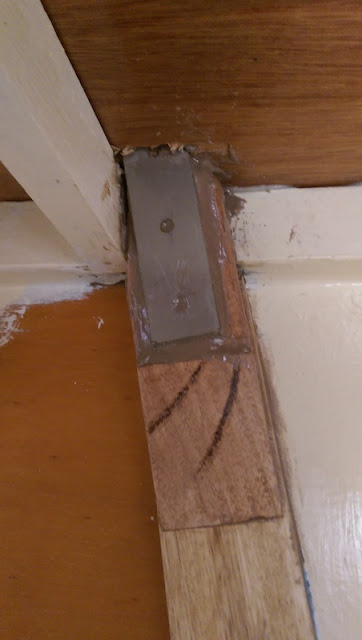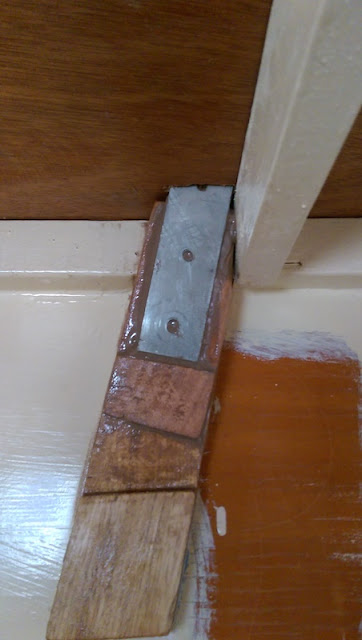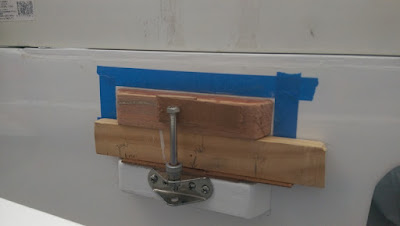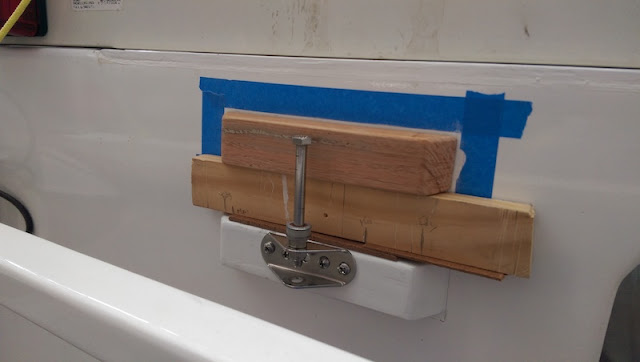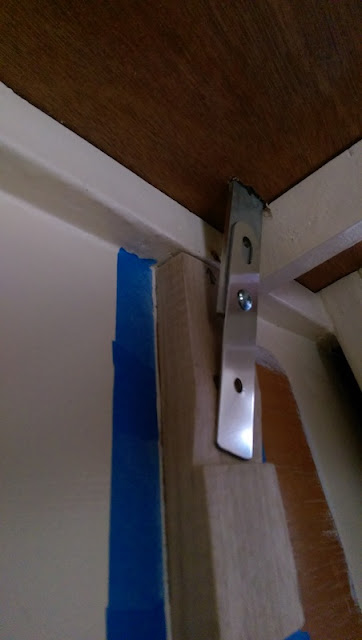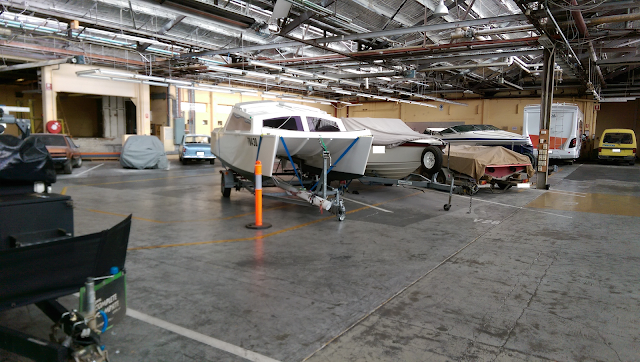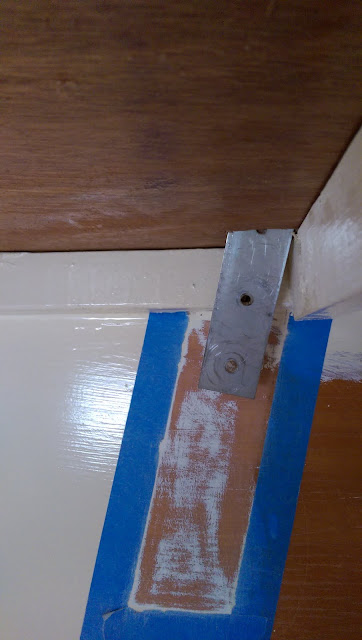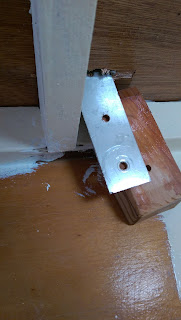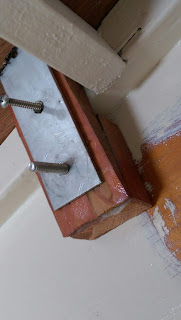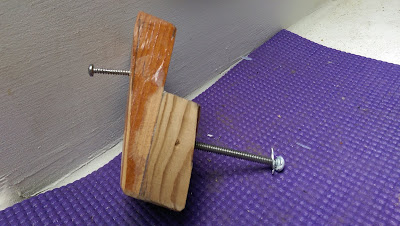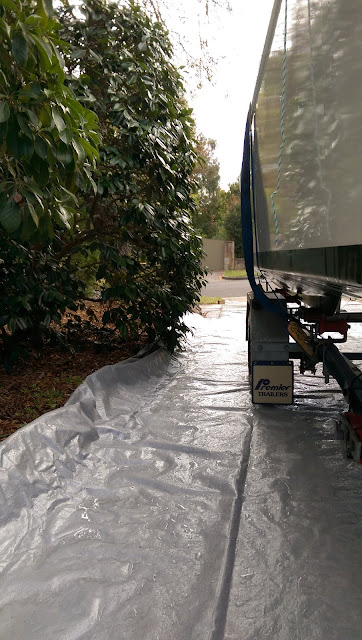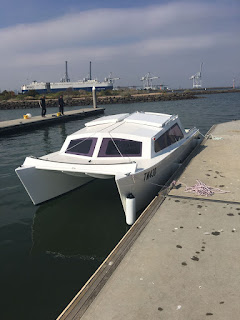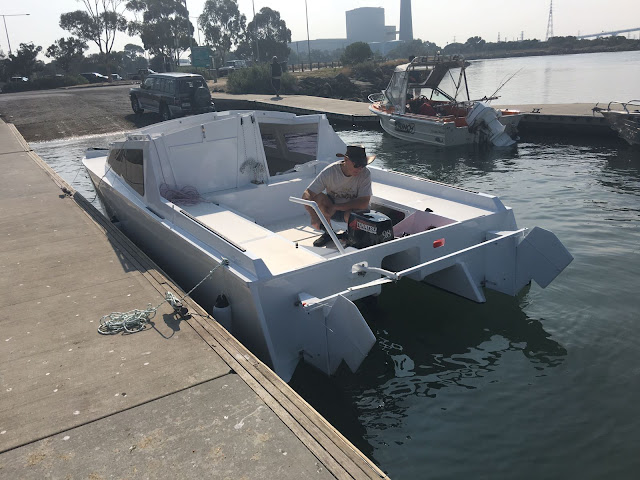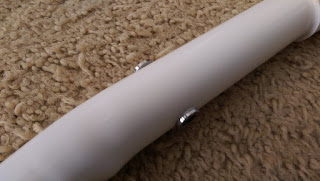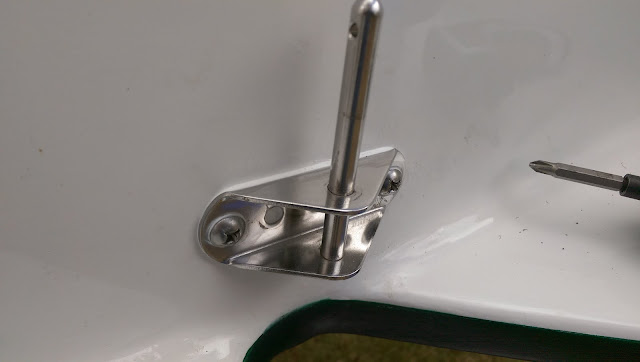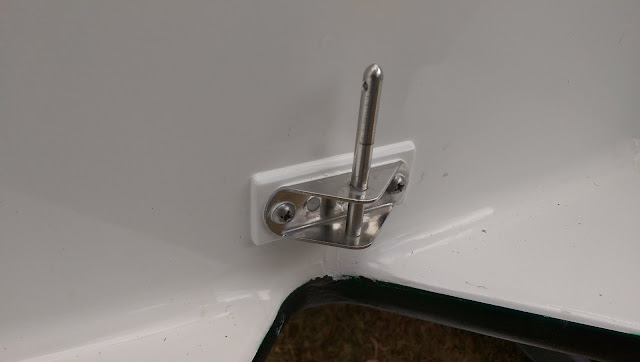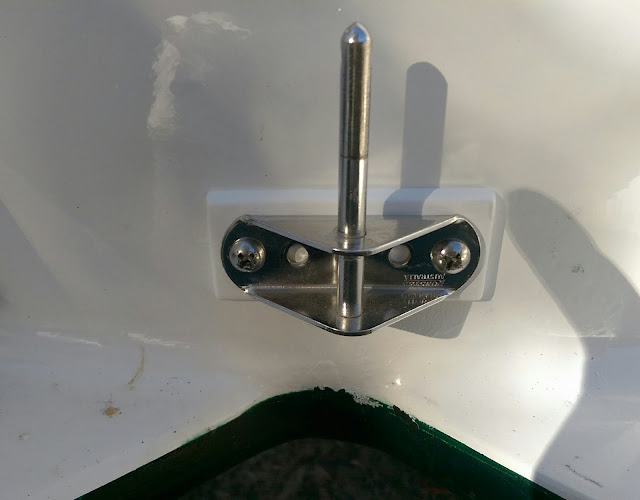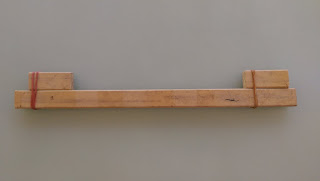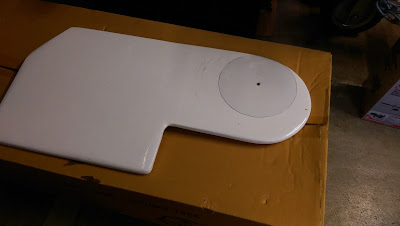The wedges that match the chainplate strap angle to the hull were epoxied into position the day before yesterday. I epoxied the chainplate extensions on yesterday - sorry forgot to take pics today.
Today we drilled the 6mm holes (from the inside) through the hardwood and hull.
Everything went really well - meaning nothing broke away or fell off. I'm very happy with the strength although it could look a bit better cosmetically on the inside.
I'll get pics of the extension pieces next time I'm at the boat. It's Christmas eve day tomorrow so I'm not sure if I'll get there.
Next is re-mounting the main traveller - drilling all the holes again, sealing the screws in with epoxy and bedding in the I-beam with Sikaflex 291.
Starboard.
Port
This blog documents the modifications necessary to get seaworthy (warts and all), then the adventures (hopefully) on board our Trailer Sailer 6.1 metre Jarcat6 Catamaran, Kismet.
Sunday 23 December 2018
Thursday 6 December 2018
Chainplate Support Epoxied to Hulls
The first support hardwood is epoxied on.
Starboard side.
Port side.
My work area - at least half of it. I'm using a chunk of core flute as a spill-catcher.
The chainplate epoxy job wasn't perfect. The next morning I visited the boat to clean up the epoxy and I reckon the bottom 2/3 are solidly bonded to the hull (correct ooze) but there are probably a few little voids at the top 1/3.
I used the two-part process where the pieces are coated with un-thickened epoxy then then left a little while and the thickened then used. Because I'm using such a slow hardener (the BoteCote non-yellowing one) the unthickened didn't really tack-off. The thicker stuff slumped a bit. I'm quite sure I couldn't move it with a Jemmy bar, so I'm not too worried.
So next stage (when our mini-heatwave subsides in a day or so) is fabricate the weird hardwood wedge shapes between the bit I just glued on and the stainless steel. Weird because the two sides are different.
Starboard side.
Port side.
My work area - at least half of it. I'm using a chunk of core flute as a spill-catcher.
Top tiller support.
The chainplate epoxy job wasn't perfect. The next morning I visited the boat to clean up the epoxy and I reckon the bottom 2/3 are solidly bonded to the hull (correct ooze) but there are probably a few little voids at the top 1/3.
I used the two-part process where the pieces are coated with un-thickened epoxy then then left a little while and the thickened then used. Because I'm using such a slow hardener (the BoteCote non-yellowing one) the unthickened didn't really tack-off. The thicker stuff slumped a bit. I'm quite sure I couldn't move it with a Jemmy bar, so I'm not too worried.
So next stage (when our mini-heatwave subsides in a day or so) is fabricate the weird hardwood wedge shapes between the bit I just glued on and the stainless steel. Weird because the two sides are different.
Labels:
Chainplates,
Tiller
Tuesday 4 December 2018
Stronger Tiller Pivot
The tiller pivot on Kismet is rather weak. The only pivot is a rudder pintle bracket with an 8mm bolt going through the tiller then the bracket. The top of the bolt is unsupported.
I've since replaced the piece of masking tape I tore while sanding back the paint.
These pictures will help remind me how I am going to clamp it - hopefully when I do the chainplate timber tomorrow.
This is how I left it today.
On William's (son) say so I have made a timber fitting the same shape as the lower one. This will be epoxied to the transom 47mm above the original (lower) one. We will then fit another rudder pintle on the new piece of timber (after painting etc.) - then use a longer bolt.
In order to ensure I glue it on in the correct place I used a few pieces of scrap wood to get the alignment right. As usual the existing support timber ISN'T ON STRAIGHT. So I've lifted the right hand side of the new piece about 2mm as a fudge. Not enough to notice that it's not parallel to the other one, and not enough to notice that it's not parallel with the top of the transom (just don't look too hard).
The paintbrush handle is the right size to wedge the new support onto the transom when I epoxy it.
I've put the pivot bolt back in temporarily to support my "paintbrush clamp".
I've since replaced the piece of masking tape I tore while sanding back the paint.
These pictures will help remind me how I am going to clamp it - hopefully when I do the chainplate timber tomorrow.
This is how I left it today.
Labels:
Tiller
Chainplate wedge stage one
Kismet in storage with my $85 eBay telescopic ladder. (Since taking this picture I have since roped the ladder to the boat for a bit of security while getting on and off.)
Makeshift workbench.
This is my cut-down chainplate extension temporarily bolted on so that I can get the taper correct.
Method: Measure for fit, get off boat, chisel and dreadnought (wood file), get on boat - repeat...
Once these timber bits are epoxied to the hulls, the next step is to accurately manufacture a timber wedge shape to fill the void behind the stainless steel bits. Again, different for each side.
Bye Kismet, see you tomorrow. I'm off to water our oversewn front lawn.
Labels:
Chainplates,
Storage
Friday 30 November 2018
Prep for new Chainplate wedges
I had a few hours for Kismet today. The port side had been mostly painted where I needed to glue (epoxy) my new support hardwood.
So I masked up the area and sanded back to almost bare wood.
The masking tape is 2 to 3mm outside the wedge area.
The masking tape is 2 to 3mm outside the wedge area.
The starboard side was not painted as much so I sanded back the paint bits and ensured that I had roughed up the epoxy coating.
I also drilled out the lower existing chainplate holes to 6mm (the scuff marks aren't from my drill).
Then I went and got lunch...it took 1 1/2 hours (not lunch, the work).
I was hoping to get the wedges epoxied in place today but it was little too late in the day as I'd like to go back a few hours later to check nothing bad has happened.
I also drilled out the lower existing chainplate holes to 6mm (the scuff marks aren't from my drill).
Then I went and got lunch...it took 1 1/2 hours (not lunch, the work).
I was hoping to get the wedges epoxied in place today but it was little too late in the day as I'd like to go back a few hours later to check nothing bad has happened.
Labels:
Chainplates
Saturday 10 November 2018
The Chainplate story begins
I retrieved Kismet from storage a couple of weeks ago but haven't had much time to do anything. I did investigate the chainplates though.
It turns out the a suspicion I had since I got Kismet was correct. The timber wedges supporting the chainplate bolts that are supposed to be epoxied to the inside of the hulls - aren't.
So there is a self tapping screw and one 3/16" bolt attempting to prevent the chainplate from being extracted up through the deck.
In additions, the wedge shown below used a combination of hardware and some softwood like oregon. The shorter piece is the softwood.
I guess that the shape of the wedge would provide some support as it bears against the lower edge of the timber running along the edge of the hull. Not good though.
I won't be replacing the chainplates but the plan is to add an extension and increase the bolt size to 6mm. I'll then add a second bolt for the extension. I'll increase the size of the screw as well. The screw and top 6mm bolt will join the extension to the existing chainplate strap.
The new wedges will be wider and be long enough for both bolts plus a bit.
(I'll also be sanding back the paint before epoxying them to the hulls.)
It turns out the a suspicion I had since I got Kismet was correct. The timber wedges supporting the chainplate bolts that are supposed to be epoxied to the inside of the hulls - aren't.
So there is a self tapping screw and one 3/16" bolt attempting to prevent the chainplate from being extracted up through the deck.
In additions, the wedge shown below used a combination of hardware and some softwood like oregon. The shorter piece is the softwood.
I guess that the shape of the wedge would provide some support as it bears against the lower edge of the timber running along the edge of the hull. Not good though.
I won't be replacing the chainplates but the plan is to add an extension and increase the bolt size to 6mm. I'll then add a second bolt for the extension. I'll increase the size of the screw as well. The screw and top 6mm bolt will join the extension to the existing chainplate strap.
The new wedges will be wider and be long enough for both bolts plus a bit.
(I'll also be sanding back the paint before epoxying them to the hulls.)
The fact that the wedges were not glued in helps me enormously as it allows me to simply make a whole new pair of wedges rather than attempt to add material to the existing wedges. I'll use about the left 2/3rds of the extension piece below (Ronstan RF47). Using the elongated hole (the very top of it) and the next hole down lines up exactly with the holes in the existing chainplate. The next hole along (about the centre one) will be the extra 6mm bolt going through the timber wedge and hull. I have stainless steel mudguard washers for the outside of the hull. I'll pre-tension the extension as much as possible when doing up the bolts.
I have had to store Kismet again but I have changed storage places and can now get access to the boat every day - about 20 minutes drive away. I am allowed to work on it while in storage (no welding or grinding or mess), so I'll be able to progress now without killing our front lawn.
Labels:
Chainplates
Tuesday 10 April 2018
Swab the decks - Washing Kismet
After our cruise up the Yarra, Kismet was very dirty with scum and dried salt.
We don't have any boat washing places within a 45 minute drive wash-so at-home it was to be.
I used the tarp normally covering the boat as a water capture and arranged the sides so no salt could get on our garden or the nature strip.
I lay another tarp in front of the big grey one (across the footpath) and rolled the sides to form a gutter. Setup and washing took about 2 hours.
Sunday 8 April 2018
Second Boat outing - to Herring Island
After greasing all the rollers on the trailer we were suddenly confronted with perfect weather today. We organised a picnic lunch and invited daughter and wife's sister to a cruise up the Yarra again - this time 8 NM up to Herring Island.
The boat slid off the trailer with ease and retrieval was easy too. Pictures are going up the river and tied up at Herring Island.
Saturday 7 April 2018
Rollers Greased
Yesterday I removed all 16 rollers (one at a time) greased the shafts and sides of the rollers and spaced the rollers (using galvanised washers) so they stayed more in line with the keel.
I can now move the boat back and forward while on land.
The next launch should be a lot easier. None of the rollers were frozen but they were difficult to rotate - now they spin freely.
The zinc plated split pins were all I could get so if I had to use them I swapped them up front where the trailer doesn't get immersed.
Labels:
Launching
Waiting for retrieval
This is a nice picture of Kismet while we waited for Fisher folk to finish their trailer refurbish. I should have tidied up that messy line first...
Labels:
Launching
Friday 6 April 2018
First Launch without drama
We launched successfully for the first time yesterday at 2:20PM at "The Warmies". We were very late getting started but it was important not to stress. We only intended to motor for a couple of hours.
Here I am putting rudders down - not so difficult that I'd bother adding any line system just yet.
Note the PVC pressure pipe tiller. It works fine but feels a bit like a toy.
We motored up the Yarra. here we are approaching the Westgate bridge.
Launching required a bit of huffing and puffing to get the boat moving off the trailer and it was the opinion of an onlooker that we should have reversed in a bit deeper.
The motoring was very nice and we did not take on any water. We ran the motor at about 1/3 throttle and generally made 3.9 to 4.5 knots.
We got back to the ramp at 4:20PM then had to wait while two fishermen fiddled with their trailer for 15 minutes AFTER they quickly launched on our side of the ramps when they saw us tying up.
Retrieval was a real pain as the rollers have 10 to 15mm of sideways movement in them and they all went the wrong way. Retrieval and prep for travel took 1.5 hours. The straps slowed us down a lot too. I'll be looking for a better way to secure the straps to the trailer.
Tuesday 3 April 2018
Tiller pivots
The SS 316 Ear expanders (similar to those I used on the Vogue) are my pivots for the tiller.
These are really inexpensive on eBay and the 8mm have a perfect 1/4" internal diameter. The 10mm have about an 8.5mm internal which is a tad sloppy but better than what would happen if I just drilled an 8mm hole in the PVC pipe. I had to buy lots of different sizes to find this out as the ear expander jewelry business isn't terribly accurate on dimensions.
These are really inexpensive on eBay and the 8mm have a perfect 1/4" internal diameter. The 10mm have about an 8.5mm internal which is a tad sloppy but better than what would happen if I just drilled an 8mm hole in the PVC pipe. I had to buy lots of different sizes to find this out as the ear expander jewelry business isn't terribly accurate on dimensions.
Labels:
Tiller
Quick and dirty Tiller
This will give us steering. It's made of 33mm OD PVC pressure pipe. It's helpful that it can be heat bent too!
I've kept all dimensions so I can make a more permanent one when I have time.
We are planning on a motor only launch on Thursday 5th April. Off to the boating shop this afternoon to do the final purchases for safety and legality (flares, fenders, boat hook etc.).
Labels:
Tiller
Saturday 31 March 2018
Pintles sealed and fitted
All the pintles have now been sealed and permanently fitted. The lower port Pintle needed a spacer. The alignment is now pretty good.
That was done yesterday.
I fitted the gudgeon fittings to the rudder boxes today and hung the rudders, so in the next couple of days we will be fabricating a new tiller system.
That was done yesterday.
I fitted the gudgeon fittings to the rudder boxes today and hung the rudders, so in the next couple of days we will be fabricating a new tiller system.
Labels:
Rudders
Wednesday 28 March 2018
Pintle spacers for alignment
I had to work this morning but I got some stuff done this afternoon.
I have replaced the two 3mm spacers made of unpainted aluminium on the port lower Pintle with a sealed, painted timber spacer - also slightly tapered to align properly.
Both top pintles required a slight change of angle to align with the lower ones. Prior to Sikaflexing tailored pieces of credit card (not an active one - I hope), the top Pintle pointed at the hull on the lower pintle instead of the lower pin. My measurements indicated the misalignment was outside the ability of the Pintle and gudgeon arrangement to compensate.
I'll permanently mount the pintles tomorrow morning. Progress - hooray!
Labels:
Rudders
Tuesday 27 March 2018
Monday 26 March 2018
Aquacote sticks to Sikaflex291
YES - Aquacote sticks to Sikaflex291. It looks pretty permanent to me but I guess time will tell.
No pictures today but I have finished painting the rudder boxes and am now ready to permanently mount the pintles (bedded with Sikaflex291) then mark and drill the gudgeon mounting holes in the rudder boxes.
No pictures today but I have finished painting the rudder boxes and am now ready to permanently mount the pintles (bedded with Sikaflex291) then mark and drill the gudgeon mounting holes in the rudder boxes.
Labels:
Rudders
Friday 16 March 2018
Rudder and Transom Progress
To level the transom height I bought an 8mm x 30mm x 2400mm piece of hardwood from Bunnings (hardware store) and carefully planed it down to 7mm. I was surprised how successful it was. It's more even than the transom that it'll mount on anyway.
I epoxied it on than gave it two coats of thinned epoxy, then painted it. It looked a bit ordinary where the epoxy had dribbled out so I trimmed away the excess epoxy and levelled each side with Sikaflex 291 - that may have been a mistake as I have to paint it again... Does Aquacote go over Sikaflex 291? I'll report back.
Almost ready for the main traveller.
While we are looking at the picture above, I'll be adding another tiller pivot support above the tiller slot. What is there at the moment seems a bit fragile. I have already bought longer bolts (see previous post).
The rudder pintles have had all the inner holes filled. I used hardwood dowel that were about 6mm too short, epoxied in then filled via a syringe with masking tape over to get a smooth finish to the transom.
I also moved the lower starboard pintle up about 9mm.
The rudder boxes have had all the gudgeon holes filled and the boxes have been painted but need a final coat.
I set myself back a bit when after test mounting the rudders to get the height correct. I found the port rudder fouled the right side of the port hull. I have ground away some timber to make it foul a bit less. It is now similar to the starboard rudder box which already had been tapered at the lower edge.
It originally had two 3mm aluminium (unpainted) spacers but when I tried that it caused the pivots to bind. I'll probably get away with one 3mm spacer.
The starboard rudder box and rudder. You can see the taper top left of the box (as it is viewed).
The rudders are too narrow for the rudder boxes (or the other way round). I made up four 180mm spacers from 1mm thick flexible PVC. It still isn't enough so I'll cut another four. I originally bought some storage containers to cut up but they shattered rather than cut when I tried cutting them with tin snips.
I have also made up two "curtains" from the same PVC sheet for the cockpit storage areas. I couldn't use the sliding hatch trick Don showed me as I have access portals in the way. This should keep out the rain (and leaves).
These will be held on with 20mm x 6mm mouldings at the top edge - just above the openings.
I have also been crawling around inside the hulls and cleaned out all the dust and rubbish.
I have also been crawling around inside the hulls and cleaned out all the dust and rubbish.
Subscribe to:
Posts (Atom)
